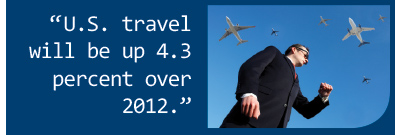Six months ago in our debut issue, Pat Charla discussed what the corporate travel landscape looked like going into 2013. Now that we’re more than halfway through the year, it’s time for a check on how we’re doing, where we’re going, and what’s breaking news in corporate travel management.
TRAVEL SPEND IS ON THE RISE—DOMESTICALLY
Trying to keep up with the projections is a full-time job. Depending upon the source, watching it month to month can drive you crazy. At least two sources are reporting that business travel spend is beating projections. According to the Global Business Travel Association (GBTA), it is increasing its outlook for 2013, thanks in part to stronger projections for domestic business travel. The association anticipates that U.S. travel will be up 4.3 percent over 2012, while group travel will be up a little over 5 percent. International corporate service firm Hogg Robinson Group, better known as HRG, also noted that client travel was up over 7 percent in the three-month period ending in June.
The flip side, unfortunately, is that outbound international travel will be slower than earlier projections, but should be up about 3 percent over last year, according to GBTA. The weaker economies in Europe and the once-robust China market are blamed for the figures.
COME ON, GET APP-Y
You know apps are hot and convenient for your customers, but you may still be shrugging them off. Here’s another reason why they are beneficial: they help your clients to stay faithful to you, according to The Beat. The article noted that travelers behave differently by portal being used, either the Web or an app. A person using a website tends to be much less loyal than one using a smartphone or tablet app. Worse, these folks also tend to price shop more when using the Web because it’s just easier to stray. In a lot of ways, an app is a lot like the pens, sticky pads, and marketing trinkets of the past, and it serves as a daily reminder that you’re ready for their business. After all, some executive travelers see more of their phones than their families at times. If the rogue apps have taught you anything, it’s that convenience is a form of love that you can show your customers.
IT’S ALL ABOUT THE DATA
Google is one of the best examples of how customer data has become a massive game-changer in marketing. It turns out, it’s really important for your business, too. In a major independent study done by global travel manager Amadeus, the findings revealed that data dramatically improved products and services offered in the hospitality industry, which enhanced their competitive position and benefits for customers. In other words, the data helped hospitality sustain their relationships with customers, offer targeted and useful upgrades and enhancements, and craft more finely tuned marketing. That can work for you, but only if you are capturing this information. There are plenty of customer relationship management software packages out there, like Salesforce and GoldMine, but being able to share those metrics with other vertical industries (and vice versa) would be magical. Can it be done?

EUROPE TACKLES AIR CONGESTION
Global ground transportation is only getting stronger, and the European Commission is definitely being proactive when it comes to the valuable but fragmented European airspace. It recently announced that it will throw 600 million Euros (approximately $793 million U.S.) to head off a capacity crunch as the number of flights over the next two decades is expected to increase by 50 percent. Commissioner Siim Kallas says, “Europe’s skies and airports risk saturation. On the ground, airports will be so crowded that flights will be unable to take off or land. Increased congestion brings with it increased safety risk—as well as delays and real economic costs. The goal is to develop the new technology needed to deliver Europe’s Single Sky—the ambitious project to reform Europe’s airspace, doubling capacity and halving air traffic management costs.” The increased congestion, according to Smart Mobility Management, costs customers and airlines nearly 5 billion Euros ($6.6 billion U.S.) in extra fuel, emissions, and delays. The improvements are good news for business travelers who need to get to their next destination faster. One final tidbit: the U.S. may still be quibbling over the Keystone Pipeline and global warming, but sustainability isn’t dead in Europe. Don’t be surprised if your international customers demand cleaner-burning vehicles, among other greener options.
WHO’S KEEPING THEM SAFE?
Global travel is not without its risk, and safety seems to be on the minds of the traveler and the company’s officials alike. This mirrors what we’ve reported in the last few months. It should be on your mind as well.
According to a survey done by travel management system KDS, travelers weren’t sure if their company even had a policy, let alone who was responsible for ensuring their safety. Of the respondents, human resources (35 percent) and security departments (31 percent) were responsible, but 15 percent said that they were on their own. This is especially significant for employees who book their own service if their companies are unaware of the details of their travel plans. A transportation company that helps to institute a plan in conjunction with the corporation or corporate travel manager will definitely have a leg up on the competition.
We’ll have the next update for you in 2014. For breaking news on all things corporate travel-related, like us on facebook.com/ChauffeurDriven. [CD0713]

